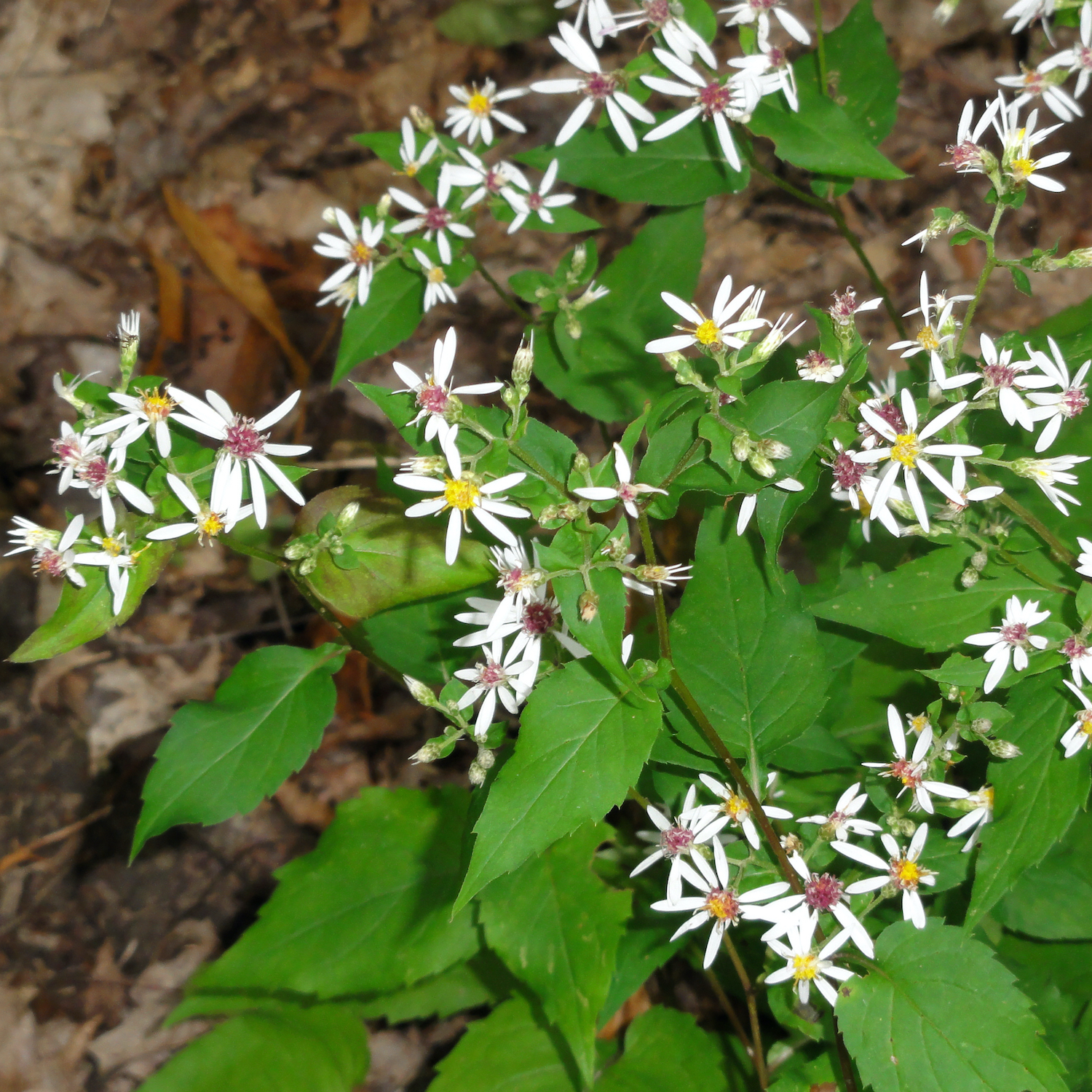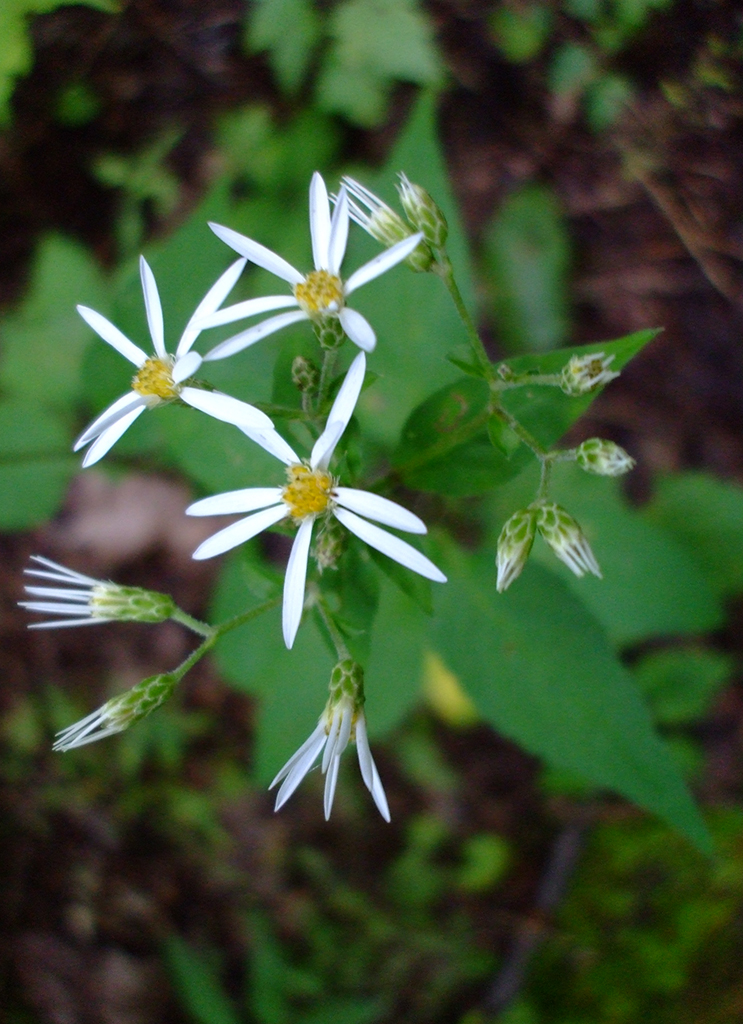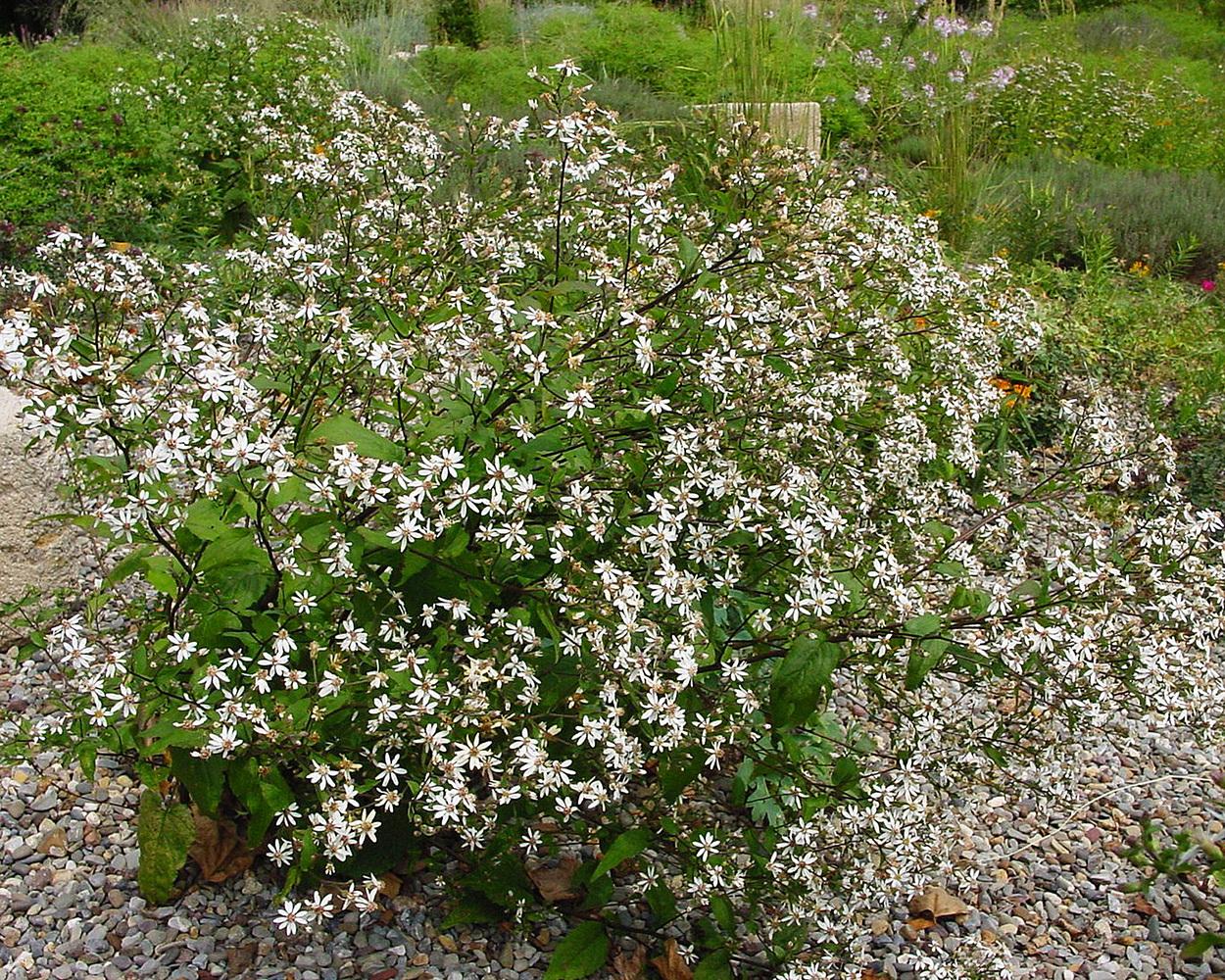
Eurybia divaricata (White Wood Aster)
Eurybia divaricata white wood-aster White wood aster is one of several native flowers that thrive in the dry, acidic shade so typical of New England. Blooming well into fall and yielding fluffy bunches of seeds thereafter, this easy-going species works just as well in all but full-sun.

white woodaster Eurybia divaricata from New England Wild Flower Society
White wood aster (Eurybia divaricata) is a fall-blooming, deer-resistant perennial plant, native to Eastern North America. It has green heart-shaped leaves, white autumn flowers, and is a great choice for planting in the dry shade underneath trees, on shady slopes, or in butterfly and pollinator gardens.

Asters White woodaster (Eurybia divaricata) Wild Seed Project Shop
Details Seeds/Packet 150 Seeds/Ounce 55,000 Germination Code C (60) ? Life Cycle Perennial Sun Exposure Partial Soil Moisture Medium-Dry Height 2 feet Bloom Time August, September Bloom Color White

White Wood Aster Wildflowers Eurybia Divaricata Stock Image Image of america, united 164097601
Common Name: white wood aster Type: Herbaceous perennial Family: Asteraceae Native Range: Eastern North America Zone: 3 to 8 Height: 1.00 to 2.50 feet Spread: 1.50 to 2.50 feet Bloom Time: August to September Bloom Description: White with yellow to red centers Sun: Part shade to full shade Water: Dry to medium Maintenance: Low Flower: Showy

Eurybia divaricata / White Wood Aster Wild Ridge Plants
Woodland aster, is a native herbaceous perennial in the Asteraceae (daisy) family. Native to the Eastern United States this wildlfower typically grows in dry open woodlands, primarily in Appalachian mountain areas. Woodland aster can grow to a mounding height of 3 feet and spread vigorously by rhizomes reaching its full growth in 2 to 5 years.

White Wood Aster (Eurybia divaricata) Western Carolina Botanical Club
Eurybia divaricata (syn. Aster divaricatus ), the white wood aster, is an herbaceous plant native to eastern North America. It occurs in the eastern United States, primarily in the Appalachian Mountains, though it is also present in southeastern Canada, but only in about 25 populations in the provinces of Ontario and Quebec.

Eurybia divaricata ‘Eastern Star’ White Wood Aster Catskill Native Nursery Plant Shop
Eurybia divaricata (White Wood Aster) is an upright, bushy perennial boasting flat-topped clusters of small starry white daisies with pink to yellow centers in late summer and fall. Blooming for weeks, the flowers are quite small, 1 in. across (2.5 cm), but they are produced in such great quantities that they literally cover the plant.

White wood aster (Eurybia divaricata, Syn.Aster divaricatus Stock Photo Alamy
Above and Below: The flowers of White Wood Aster are composed of 5 to 10+ white ray florets surrounding a central disc of numerous yellow disc florets that turn reddish at maturity. The rays can also have a lilac tinge of color. They also seem to pointing in various directions. The phyllaries of the flower head (below left) have rounded to pointed in shape and are whitish with dark green tips.

Aster divaricatus White Wood Aster Keystone Wildflowers
The sparkling wines from this small, terroir-driven DOCG wine area in Lombardy, northern Italy, are Italy's answer to Champagne: high-quality, home-grown bubbles of prestige. If these wines are less well known outside Italy it's because the majority of the 20.9 million bottles [ figure for 2021. Source: Franciacorta Consortium] produced in.

Eurybia divaricata White wood aster3 AH Bowman's Hill Wildflower Preserve
Characteristics Descriptions Light Requirements part-sun, part-shade, shade Soil Moisture dry, moist Soil Description acid, neutral, rich, clay Height 1'-3' Recommended Spacing 12"-16" Bloom Time August, September, October Bloom Color white Hardiness Zone 4, 5, 6, 7, 8 More Filters deer resistant, colonizing, pollinator favorite, shade garden plant

White Wood Aster (Eurybia divaricata syn. Aster divaricatus) Monticello Shop
White Wood Aster • • • Summary The delicate, airy clouds of white wood aster (Eurybia divaricata) are a must-have for every fall garden. This lovely aster is among the first to bloom in late summer. Small, white, daisy-like flowers with yellow centers that fade to red are borne atop dark green to black stems.
Eurybia divaricata white wood aster Herbaceous Perennial/RHS Gardening
Eurybia divaricata can also be found growing along roadsides, woodland edges, and open clearings. White wood aster grows to 2-3 ft tall, spreading by rhizomes or by seed. Numerous white, ray flower petals around a central yellow disk decorate a delicate stem, atop heart-shaped leaves. Blooming September to November.

White Wood Aster (Eurybia divaricata) Western Carolina Botanical Club
Eurybia divaricata (formerly Aster divaricatus ), commonly known as the white wood aster, is an herbaceous plant native to eastern North America. It occurs in the eastern United States, primarily in the Appalachian mountains, though it is also present in southeastern Canada, but only in about 25 populations in the provinces of Ontario and Quebec.

Eurybia divaricata White Wood Aster Prairie Moon Nursery
White wood asters, Eurybia divaricata, are native perennials in the Asteraceae family, which also includes chrysanthemums, coneflowers, and sunflowers. Photo by Krzysztof Ziarnek, Wikimedia Commons, via CC BY-SA. We link to vendors to help you find relevant products. If you buy from one of our links, we may earn a commission.

Photo of the entire plant of White Wood Aster (Eurybia divaricata 'Eastern Star') posted by
by Lorenzo Cogo. A signature cheese of the Valtellina Valley, Bitto is named after the nearby Bitto River. Bitto is only produced in the summer - when grass appears on the alpine meadows of Valtellina, farmers let their cow's out to feed and use the milk to make Bitto. The cheese is made from cow's milk, but with 10-20% of goat's milk.

White Wood Aster (Eurybia divaricata) Western Carolina Botanical Club
The small, white daisies of the shade-loving native white wood aster ( Eurybia divaricata) lighten up the fall woodlands. Rare for asters, this species tolerates partial shade. It thrives in open woodlands and along the edge of woodlands, growing best in moderate to dryish soils. Pollinating insects appreciate the opportunity to stock up on the.